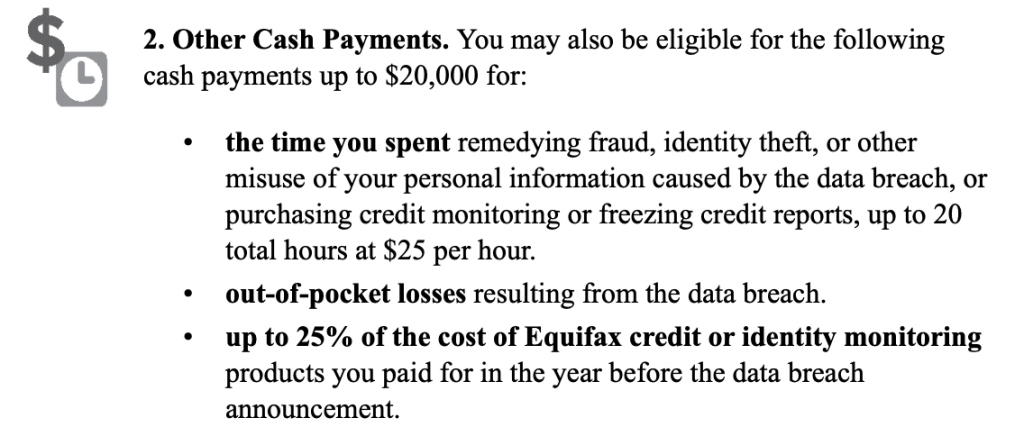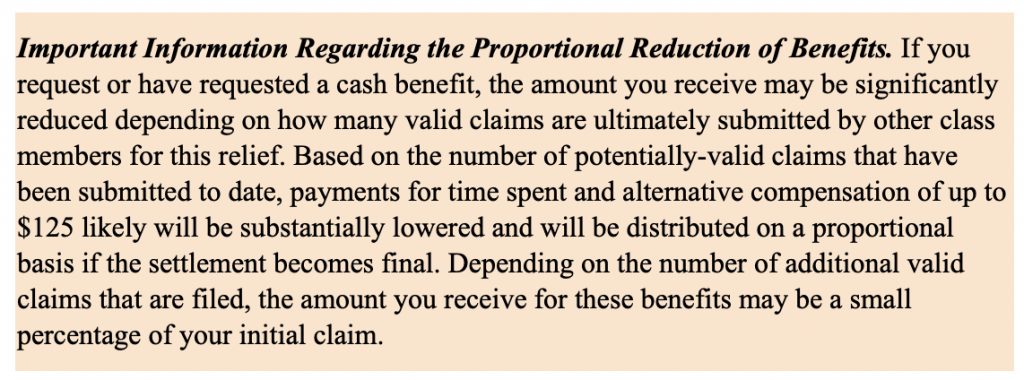Consumers can expect less cash from Equifax than originally stated in its class action settlement — a lot less cash.
You probably received the “COURT APPROVED LEGAL NOTICE” email from Equifax that included the new warning. About half of all American adults – more than 145 million people — were affected by the breach and it turns out a lot of them want cash benefits. Which is severely reducing the amount of money each individual will get.
Here’s how to read between the lines of the Equifax mail and what you should do next:
First, find out if you’re eligible for benefits. All affected individuals are automatically part of the class action suit but you have to file a claim to get settlement benefits. Read the class action settlement here and visit the official Equifax breach website for a more reader-friendly version that includes a robust FAQ section. Be careful, however, of imposter settlement websites. Don’t click on web ads or email links about the settlement. Use the links in this post or use your search engine to navigate to the official site.
Settlement Benefit #1

The explanation of the two options, as stated in the email, is misleading.
If you opt for the $125, you’re not going to get close to that much. The portion of the settlement that covers this benefit is $31 million and each claim gets an equal amount. So if 25% of participants choose cash, for example, then each person gets an 84-cent check.
To complicate things further, if you filed your cash claim before August 2, 2019, you now have to take another step by October 15, 2019, or your claim may be denied. You must now enter your claim number here to verify your claim or choose to change your claim to free monitoring instead. Equifax should have sent you an email about this in August. It added this step because so many people filed for the cash payment option and it’s essentially an opportunity to choose free credit monitoring instead.
The Federal Trade Commission (FTC) is urging participants to choose free monitoring (see the complete FTC instructions) while others believe credit monitoring is ineffective because it doesn’t prevent identity theft.
Settlement Benefit #2

This section of the email is meant to be an overview — for full instructions visit the website FAQs or the Consumer Reports page spells it out. Consumer Reports also helps you identify time and losses you may not have considered.
It’s important to know that the first 10 hours of your time spent, or $250, is self-certified. You do not need to prove how you spent this time but you do need to explain it. For the second 10 hours, you need documented proof. However, as with the cash option in Benefit #1, there is $31 million available for the time-spent portion of the settlement and it’s split evenly between the claims.
There is more money available for out-of-pocket losses —$318 million. Plus another $125 potentially.
Settlement Benefit #3

Other than what the email states here, there is little information available about what’s included in these free services. However, it is clear that everyone — including people who are not participants in the settlement — is eligible for these services. It appears there will be a call center to help people with the step-by-step process of dealing with companies, government agencies, and credit bureaus while recovering from identity theft and fraud. Whether or not this public service is a true benefit for people filing a claim is open to interpretation.
If you have questions about the restoration services, Equifax asks that you call the settlement administrator at 1-833-759-2982 for information.
Settlement Disclaimer: “… benefits may be a small percentage of your initial claim.”

The last 10 words in the email’s colored box sum it up. Equifax is saying you’re probably not going to get the $125 from Benefit #1 or full compensation for your time spent in Benefit #2 because of the enormous number of claims. Remember, yours is one of 146 million potential claims.
Settlement deadline and claim verification

Don’t miss this deadline if you incurred provable out-of-pocket losses or if you want free credit monitoring — these are probably the two actual benefits you can expect. The earliest you will receive them will be January 23, 2020. Also, don’t forget that if you filed a cash claim for Benefit #1 before August 2, you DO need to update your claim (see Benefit #1 above).
Settlement option to opt-out

This section of the email explains how to opt-out but not why to opt-out. Opt-out if you may want to file your own lawsuit against Equifax at some point — you can’t be part of the class-action suit and also file another suit. You might choose this option if your time spent and/or out-of-pocket expenses are more than the $20,000 per person cap or if you’re concerned you may not get full compensation due to the proportional disbursement of the capped amount.
Here’s Leapfrog’s take on why the Equifax breach was worse than all the others.
So far, Equifax reports it has spent about $1.44 billion recovering from the attack, which includes improving its technology and paying legal fees.
Leapfrog believes organizations that collect private information belonging to others must do everything reasonable to protect it. And when that private information IS the business, protecting it should be job one.
Unfortunately, you should not rely on them to do so. There are too many things that can go wrong. You need to be an active participant in protecting your own data so when breaches occur – and they will – you reduce the likelihood of being a victim of cybercrime.
We recommend following this advice about passwords, usernames, and ransomware, being aware of the most popular online scams, and freezing your credit reports then unfreezing them temporarily when someone you trust needs access.

